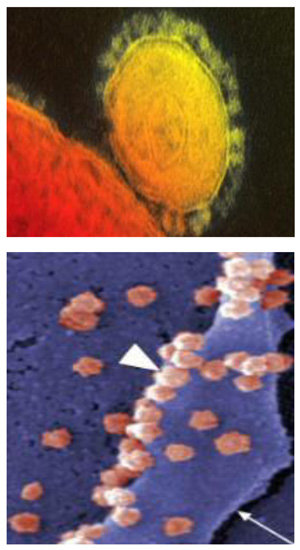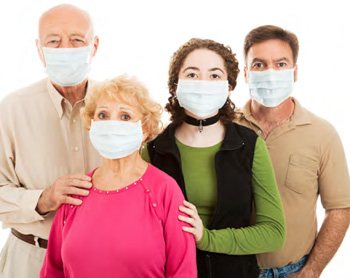The MERS virus – short for Middle East Respiratory Syndrome – has surfaced in the region. S R Khanna throws light on the symptoms and claims that hydroxyl-releasing technology can minimise the viral infection risk by improving IEQ.
The MERS virus – short for Middle East Respiratory Syndrome – has surfaced in the region. S R Khanna throws light on the symptoms and claims that hydroxyl-releasing technology can minimise the viral infection risk by improving IEQ.
 Officials in the Saudi Arabian Health Ministry recently reported a rise in the rate of Middle East Respiratory Syndrome (MERS) infections and deaths. Fourteen confirmed new cases of MERS were reported, predominantly in the capital Riyadh and the coastal city of Jeddah and in Mecca. Five confirmed MERS deaths have brought the death toll to 313*. A rise in MERS has also been reported throughout the Middle East and other countries frequented by Middle Eastern travellers, including the UAE, Oman, Qatar, Jordan, Kuwait, Italy, Malaysia, Tunisia, France, and UK.
Officials in the Saudi Arabian Health Ministry recently reported a rise in the rate of Middle East Respiratory Syndrome (MERS) infections and deaths. Fourteen confirmed new cases of MERS were reported, predominantly in the capital Riyadh and the coastal city of Jeddah and in Mecca. Five confirmed MERS deaths have brought the death toll to 313*. A rise in MERS has also been reported throughout the Middle East and other countries frequented by Middle Eastern travellers, including the UAE, Oman, Qatar, Jordan, Kuwait, Italy, Malaysia, Tunisia, France, and UK.
The jump in cases is of particular concern, because Saudi Arabia will host pilgrims from around the world in July during the holy month of Ramadan, as well as in early October when millions of worshippers perform the annual Haj.
What is MERS?
MERS is a viral respiratory illness caused by a variant of the coronavirus, called Middle East Respiratory Syndrome Coronavirus (MERS-CoV) that was first described in September 2012.
Since that time, it has continued to fester in the Middle Eastern countries.The disease causes acute respiratory illness manifested as coughing, fever and pneumonia.
The virus is highly infectious and is transmitted through the air and from contact between people and from contaminated surfaces. Epidemiologists have not confirmed the source of the virus but speculate that it may reside in several types of animals that transfer the disease to humans. Camels and bats have been tested and found to harbour the MERS virus. Other animals may also be involved.
The disease is of particular concern, because there is no vaccine or treatment and the fatality rate is 49%. A spokesman for the World Health Organisation in Geneva recently said that it was tracking the incidence of MERS worldwide and is “concerned” about the rising MERS numbers in Saudi Arabia and throughout the Middle East.
The risk of infection is reportedly highest in densely populated cities, public areas and transportation centres/vehicles where the airborne virus can become concentrated.
New technology to minimise viral infection risk
 Hydroxyl-releasing technology based on natural photochemistry driven by the sun’s ultraviolet energy is known to kill 99.99% of bacteria, viruses, mould and other pathogens in the air and on surfaces safely in areas as small as an office or as large as several million cubic feet**. The technology sanitises an area by generating effective levels of atmospheric hydroxyl radicals – Nature’s powerful atmospheric sanitising oxidant.
Hydroxyl-releasing technology based on natural photochemistry driven by the sun’s ultraviolet energy is known to kill 99.99% of bacteria, viruses, mould and other pathogens in the air and on surfaces safely in areas as small as an office or as large as several million cubic feet**. The technology sanitises an area by generating effective levels of atmospheric hydroxyl radicals – Nature’s powerful atmospheric sanitising oxidant.
Atmospheric hydroxyl radicals (hydroxyls) are continuously produced by the action of the sun’s radiated energy on water vapour in our atmosphere. There are, on an average, two million hydroxyls in each cubic centimetre of ambient outdoor air during daylight hours1. They keep air safe to breathe by decomposing natural and man-made pollutants and killing microorganisms. They sanitise air and surfaces by a natural process called lysing, where the hydroxyls react chemically with the lipids and proteins in the cell membranes of bacteria, viruses and other pathogens and disrupt their structure. The interior contents of the cells leak and the organism is destroyed. The mechanism for killing microorganisms is not biological, so the bacteria or viruses cannot develop any form of immunity. Measured kill rates across a broad range of microorganisms is consistently over 99%.
Airborne hydroxyls are efficient sanitising agents, as they react with a broader range of chemicals and are over one million times faster than ozone, bleach or other sanitising agents. They react so fast that they are consumed within a few seconds, so they never accumulate.
Indoor environments are rapidly depleted of natural hydroxyls and build up unhealthy levels of chemicals, bacteria and viruses. In this regard, hydroxyl-releasing technology eliminates this build-up and restores Nature’s safe balance indoors.
Ultraviolet (UV) lights have been used for years to sanitise surfaces. However, most UV lights have insufficient power to generate hydroxyls. They are only able to sanitise surfaces within a few inches of their source when there is sufficient exposure time. They are ineffective in sanitising air that circulates past their source. Hydroxyl-releasing technology, on the other hand, involves UV optics that are completely different: They release intense UV radiation using different wavelengths optimised for generating hydroxyls concentrations which match levels found in Nature. By mimicking the natural process, hydroxyl-releasing technology achieves indoors, what Nature achieves outdoors.
The writer is from Odorox InAir ME. He can be contacted at: srkhanna@emirates.net.ae
* Statistical data are provided by the writer and is applicable as on May 5, when the article was received.
** US-based HGI Industries has developed a series of Odorox® Systems using Hydroxyl-releasing technology. The company confirms that the systems are tested by Intertek and have received the ETL safety mark. It further confirms that it has complied with all required US safety testing and has the necessary approvals to market the product and that it has also conducted independent third-party toxicology safety studies to prove there are no health risks.
Disclaimer: The opinion regarding the efficacy of the technology to combat MERS is that of the writer and not necessarily endorsed by CCME/CPI Industries.
Reference:
1: DE Heard, Professor at the University of Leeds, UK. Analytical Techniques for Atmospheric Measurement, Blackwell Publishing, 2006.
Copyright © 2006-2025 - CPI Industry. All rights reserved.